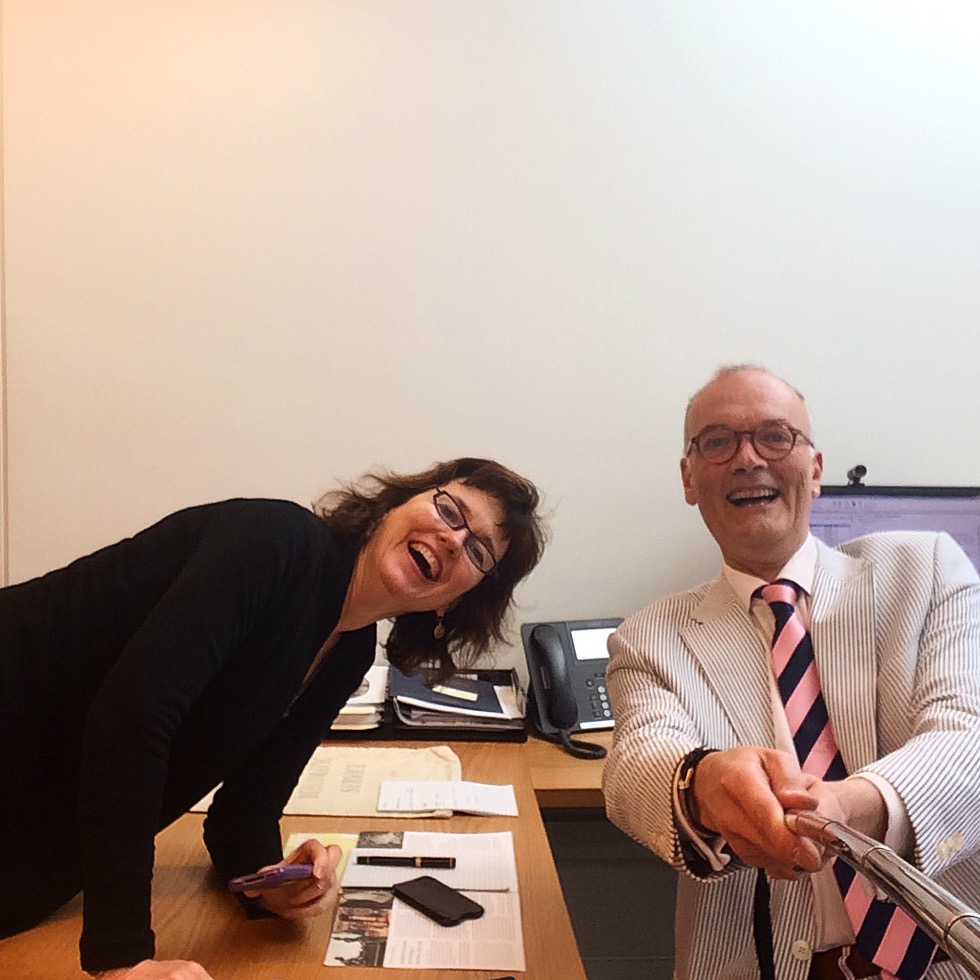Last week ABC Television came to interview me about selfie sticks. The story was prompted by the announcement that the Metropolitan Museum of Art in New York has lately prohibited the use of these inside their galleries. So far as I am aware we have not yet encountered the phenomenon, but no doubt we will before too long.
Before last September I had never even heard of a selfie stick. When our friends from the National Gallery of Indonesia left us to go home to Jakarta, they made me a present of one, and discreetly I had to find out what it was for. It's a no brainer, really. Any collapsible metal pole, other than a crutch or a walking stick-these are more or less anchored to the floor, or ought to be-that is swung about at arm's length is best banished from our galleries (together with tripods and monopods) lest some bystander got hurt or a work of art were knocked, scraped or skewered. The problem is not the photography itself, for this we now encourage-without flash. Nor indeed do I personally take exception to the broader concept of the selfie, even when broadcast through antisocial media; this seems to have become firmly embedded in the smart phone generation as a means by which to alert the world to the fact that they were in a particular spot at a certain moment. Indeed I confess I have done this myself on a number of occasions.
Still, I was not prepared for the immediate, powerful and widespread response to my remarks, overwhelmingly positive. Radio stations across the country have sought follow-up interviews, and we have garnered hundreds of approving comments on our Facebook page. Only one disaffected person has told me that my position on selfie sticks is actually pretentious, viz. that of "a snobby, dusty fart". Oh well, I suppose if the caps fits... We even made it into the press in Venezuela and in Honduras.
Clearly we have touched a nerve, for there seems to be, on the one hand, a widespread feeling that the selfie phenomenon either reflects some innate cultural narcissism against which many Australians now feel inclined to react, or else that the ebullient capturing of selfies in public places can, at times, intrude upon the personal space of selfie-sceptical bystanders and has an irritating effect comparable with the nocturnal drone of a mozzie. However, it seems indisputable, on the other, that the selfie urge is not just firmly established but spreading with vim and vigour, above all among the young, the very young, and the even younger. Between these two positions, for and against, it may be that we are witnessing the opening of a new generation gap, certainly a fundamental division in outlook.
Hitherto I suppose my position has been neutral, for, as I mentioned before, we have not yet encountered the problem at the National Portrait Gallery, but the issue has got me thinking: How hard it is for institutions to keep pace with the rapid and obviously accelerating evolution of manners: the selfie, the tweet, e-tiquette, et cetera. No doubt I will eventually be asked to rule on drone usage inside our galleries. To this extent we art museums are inevitably followers in the wake of social usage, adapting when necessary, and not leaders. Yet we do not simply look forward; occasionally it is vital to look back, recapture the vanished manners and customs of the past, and explain to our visitors what might otherwise be an inexplicable fleck of detail that sheds light on what are now wholly forgotten aspects of daily life-a detail that, when recovered, can go as far as to restore to our portraits lost meanings.
For example, who now remembers the "swizzle stick"? Some time ago, I saw this object referred to in print as a "champagne whisk," but many people throughout the British Commonwealth who are over the age of fifty or sixty will recognize, not to say cherish it, as a sadly neglected but once indispensable cocktail-party accessory. The Oxford English Dictionary traces the earliest appearance of this attractive term to British colonists at leisure in the tropics, namely John Whetham Boddam-Whetham (1843-1918), a first class cricketer, tourist, and adventurer, who mentioned the swizzle stick as a West Indian novelty in his useful Roraima and British Guiana, With a Glance at Bermuda, the West Indies, and the Spanish Main (London: Hurst and Blackett, 1879). Six years later, whilst visiting the Caribbean on board their yacht, the Sunbeam, Lord and Lady Brassey-Lord Brassey was governor of Victoria from 1895 to 1900-were so taken by the swizzle stick that, in due course, after returning to England, they distributed them widely as amusing gifts.
Experienced swizzle stick users once appreciated the benefit of expelling the majority of large bubbles from a glass of champagne, thereby allowing the tiniest ones to do their job of seduction unimpeded. A gentle stirring motion was all that is necessary, because anything more vigorous might cause spillage, or some other embarrassment. Swizzle sticks could also be used to attract attention, or for self-defence. One thinks of the better nightclubs of Beirut in the sixties, of Noel Coward in Jamaica, or Cairo in the reign of King Farouk. The only person I have ever seen using a swizzle stick was the late Frank Doria Pamphilj, who suffered from wind. This was in Rome in 1987.
I daresay one might draw sobering conclusions from a careful analysis of the socio-historical trajectory that separates the swizzle from the selfie stick but I doubt if they would add up to anything like progress. Perhaps I am being unduly pessimistic. I hope so.














